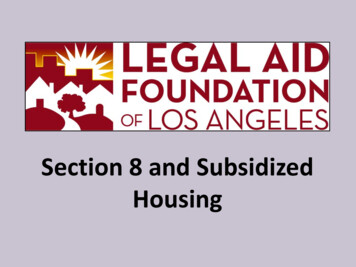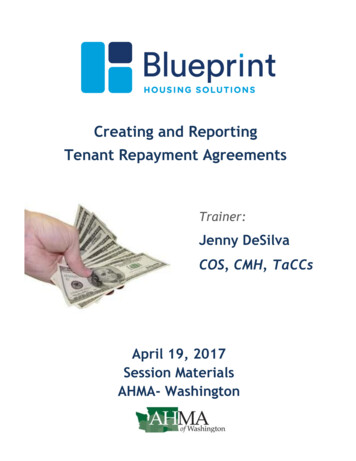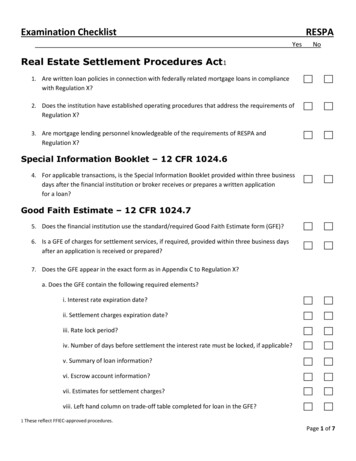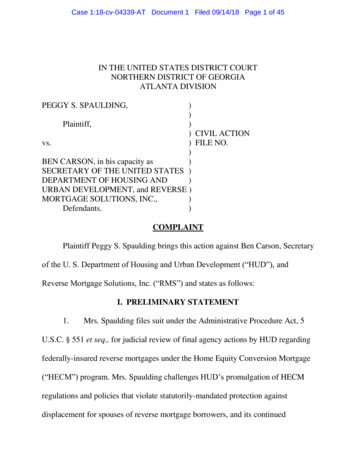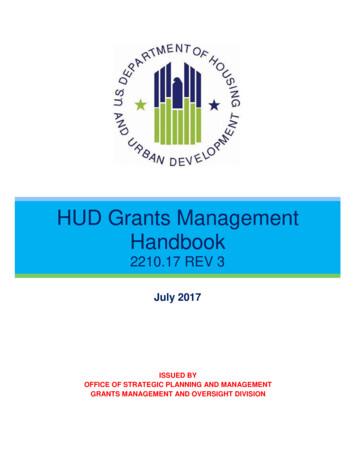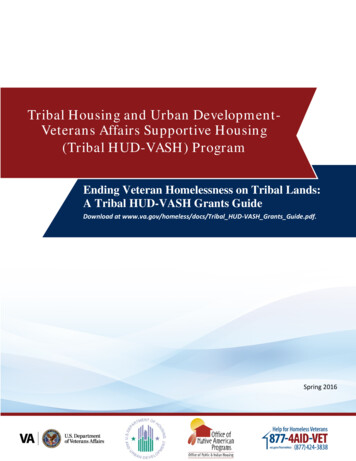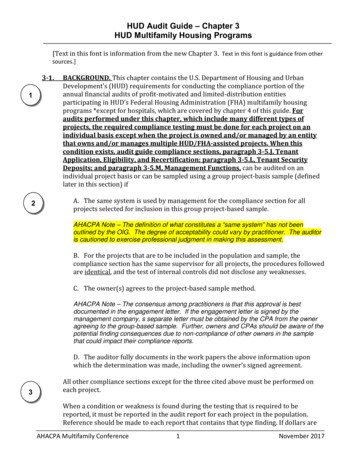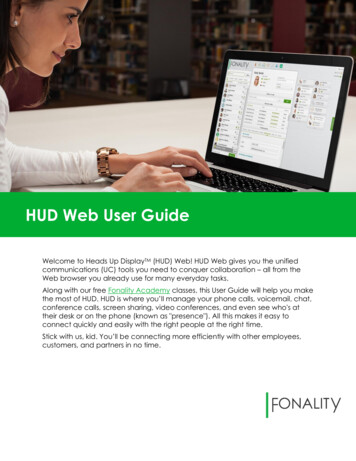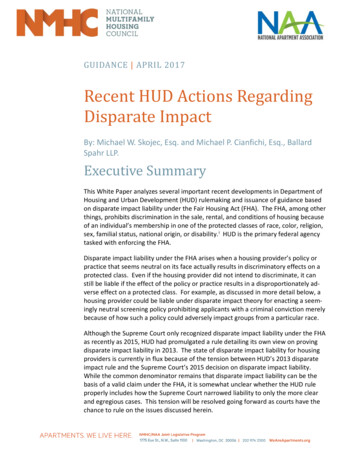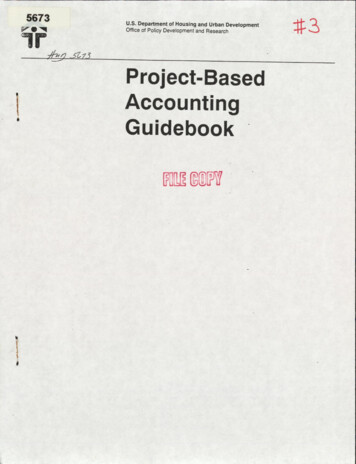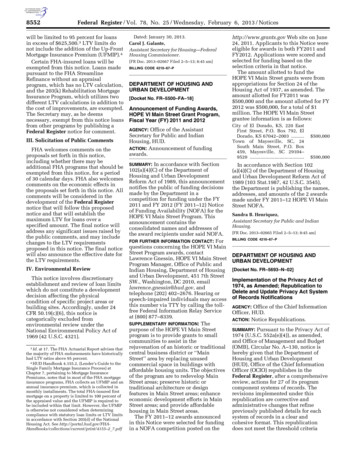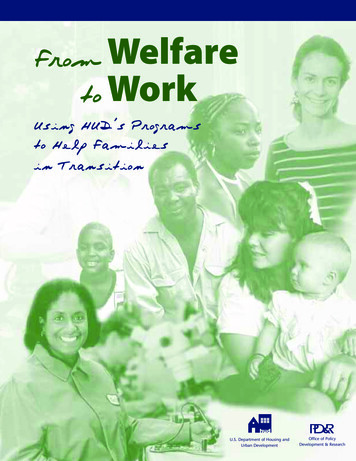
Transcription
WelfareWorkU.S. Department of Housing andUrban DevelopmentOffice of PolicyDevelopment & Research
ForewordI am pleased to present From Welfare to Work: Using HUD’s Programs to Help Familiesin Transition, a profile of the creative ways our programs are helping low-income fami lies succeed.Welfare reform has brought with it many new challenges. For instance, time limits andwork requirements are significantly changing the lives of many families that receivehousing assistance. HUD plays a vital role in helping our nation meet these challenges.Although much more remains to be done, we’re off to a good start. For families thatneed housing assistance to make the transition to work, HUD offers the Welfare-toWork Housing Voucher program. We also have helped other Federal agencies — such asthe Departments of Labor and Transportation and the Small Business Administration —shape their welfare-to-work efforts to assure that the benefits of their programs willreach residents of public and assisted housing. Finally, we have examined our own programs and revised them, as necessary, to make sure that they, too, can be used individu ally and in partnership with other public and private resources to support families whoare determined to succeed under welfare reform.This publication details 25 functional welfare-to-work models that make use of a varietyof HUD programs. It is part of the Department’s ongoing effort to assist public housingand community development agencies, community-based nonprofit organizations, andothers to respond to the challenges and opportunities posed by welfare reform. The ini tiatives profiled feature diverse program designs that include employment and training,career counseling, job placement assistance, job retention services, and self-employmenttraining and support. They also include funding from the full range of HUD programs,many of which are bundled with funds from other Federal, State, or local sources.By demonstrating how local initiatives can creatively use our programs to help familiessucceed on the path to self-sufficiency, these examples are both instructive and inspira tional. I encourage you to use this publication as a learning tool — a source of modelsthat can be adopted as they are or adapted to reflect the unique circumstances of yourown community.Andrew CuomoSecretary of Housingand Urban DevelopmentForewordI
WelfareWorkPrepared For:U.S. Department of Housing and Urban DevelopmentOffice of Policy Development and ResearchAuthors:Michelle WoodGretchen P. LockeB. Hannah ShulevitzDiane M. PorcariSandra NoldenJean AmendoliaPrepared by:Abt Associates Inc.Contract DU100C000005964March 1999
Table of ContentsIntroductionFamily Self-SufficiencyClearwater, FloridaProvidence, Rhode IslandSan Diego, CaliforniaNew Jersey15202328Empowerment Zones/Enterprise Communities (EZ/EC)Norfolk, VirginiaCleveland, OhioDetroit, Michigan313741Comprehensive Grant Program Fund (CGP)Phoenix, ArizonaRichmond, Virginia4347Neighborhood Networks (NN)Grand Forks, North DakotaMarrero, Louisiana5155Family Investment Centers (FIC)Los Angeles, CaliforniaMacon, GeorgiaHartford, Connecticut596468HOPE VIMilwaukee, Wisconsin71Campus of Learners (COL)Seattle, WashingtonDenver, Colorado7783Contents V
Table of Contents, continuedHUD’s Supportive Housing Program (SHP)New York, New York87Birmingham, Alabama92Community Development Block Grants (CDBG)Bangor, Maine95Raleigh, North Carolina98Section 3Baltimore, Maryland101Columbus, Ohio105Step-UpJoliet, Illinois109YouthbuildSt. Louis, MissouriInternet Information ResourcesVI C o n t e n t s113
IntroductionThe Personal Responsibility and Work Opportunity Reconciliation Act of 1996 hasbrought sweeping changes in welfare programs and policies. The Act replaces a 65-yearentitlement to assistance for eligible families with the Temporary Assistance to NeedyFamilies (TANF) block grant to the states. While the block grant allows considerablediscretion at the state level, it is clearly intended to help move welfare clients into workand off assistance. In addition to establishing a five-year lifetime limit on an individual’seligibility for assistance (with some exceptions), it also requires adult recipients to findwork within two years of receiving assistance. To reinforce the work participation rule,states must meet specific levels of active client employment or face fiscal penalties.The impact of these changes on the lives of public housing residents and Section 8 partic ipants is significant because approximately half of all HUD-assisted families with chil dren received welfare benefits in 1996.1 As public housing agencies assess the effect ofwelfare reform on their operations and on their residents, HUD is providing them withinformation, funding, and local policy options to serve their TANF beneficiaries.This publication profiles 25 initiatives where innovative providers are adapting existingHUD programs to help families transition from welfare to work. Designed as a resourcefor public housing agencies, community residents, local community development agen cies, homeless service providers, assisted housing owners and other local serviceproviders, it features promising programs already in place. The activities compiled herewere identified by polling HUD Headquarters and Field staff as well as other knowledgeable sources for recommendations. Although the outcomes of most of these programshave not been formally evaluated, their results to-date are encouraging and they showreal potential for helping public assistance clients transition to employment.The case book is organized in two parts. The first highlights some common themes thatrecur through multiple programs. The second part presents detailed profiles of individ ual programs. It begins with a table summarizing the key program features. This tablemay be useful to readers interested in specific types of programs, such as those targetingparticular population segments or those focusing on specific types of employment.Suggested additional resources are listed in the Appendix.Recurring ThemesThe initiatives described here feature diverse program designs, funding sources, targetingstrategies, and organizational structures. Despite their diversity, however, they illustratea number of common, recurring themes — themes which may be the foundation for theirindividual and collective potential.Designating Lead Agencies1 Khadduri, Jill, Mark Shroder,and Barry Steffen. 1998.Welfare Reform Needs andHUD-Assisted Housing:Measuring the Extent ofNeeds and Opportunities.Local program sponsors of these HUD-supported programs include what one thinks ofas “typical” housing organizations — public housing agencies (HAs) and non-profitorganizations that administer Section 8 rental assistance programs. In the course of com piling this case book, we learned of a number of programs administered by entities otherthan the “usual suspects.” Thinking creatively about organizational structures can helplocal programs tap into additional resources. For example:Introduction1
The Housing Authority of Baltimore City and the Richmond, Virginia Housing andRedevelopment Authority have each established non-profit subsidiaries to createemployment opportunities for public housing residents. In Norfolk, Virginia, a nonprofit organization affiliated with the local housing agency coordinates workforcedevelopment activities in Norfolk’s Enterprise Community (EC). The HA serves asthe funding conduit for EC funding.In Seattle, the local Private Industry Council holds the contract to coordinate theSeattle Housing Authority’s self-sufficiency efforts under the Campus of Learners andHOPE VI programs.In Detroit, a private medical center has established the New Beginnings training program to help residents of the Lower Woodward Corridor (now a HUD EmpowermentZone) prepare for jobs in the health care field. The majority of the program’s partici pants are public housing residents. In Raleigh, the North Carolina Home BuildersAssociation uses Community Development Block Grant (CDBG) and other funds toprovide construction training for unemployed and underemployed city residents.In New York City, the collaborative efforts of a not-for-profit housing and communitydevelopment organization and an affiliated supportive services provider havelaunched an employment training program that is linked to supportive housing.Establishing Effective PartnershipsAchieving self-sufficiency forces people to develop the technical and workplace skillsnecessary for employment, make arrangements to ensure that they can get to work(such as child care and transportation), identify employment opportunities, andobtain and retain employment. For many, the task is substantial, and the services andexpertise needed to help them may exceed the capacities of the individual sponsoringorganization.Many of the programs featured in this publication rely on collaboration between twoor more partner agencies. In addition to filling gaps in the service spectrum, creativepartnerships can also help one or more partner meet funding requirements.Successful partnerships are often the result of active outreach to potential participants,carefully structured Memoranda of Understanding (MOU) among partners, andwatchful oversight through coordinating committees or advisory groups representingall involved. Some examples include:The Denver Housing Authority’s (DHA’s) North Lincoln Homes Campus of Learnersprogram is supported by a number of partners. The Mayor’s Office of Employmentand Training operates a One Stop Center near the development, offering employmentreferrals and support to North Lincoln Homes residents. A community-based organi zation provides small business and entrepreneurial skills training and employmentreferrals as well as other services. DHA also has an MOU with the local TANFagency to supplement case management services for public housing residents.2Introduction
The Seattle Housing Authority has contracted with the local Private Industry Councilto manage the Campus of Learners program at the HOPE VI Holly Park site. Othersubcontracted partners include the public schools, a refugee services agency, and acommunity college. MOUs have been established with a resident advocacy organiza tion and three social services organizations.The Family Self Sufficiency Program in Clearwater, Florida is supported by partnershipswith local educational institutions, the Job Training Partnership Act (JTPA) program, aswell as the Urban League, the Lions Club, and other service providers.Leveraging Resources as Well as ExpertiseJust as no one organization may have all the expertise to implement a particular strategy,no single funding source is likely to provide enough financial support to accomplish allgoals. Virtually all of the initiatives featured in this case book have more than one source ofsupport, including in-kind contributions and creative financing strategies. For example:The YouthBuild St. Louis AmeriCorps program and the Housing Authority of the City ofLos Angeles both successfully sought competitive Department of Labor (DOL) Welfareto-Work grants to support their programs.The San Diego Housing Commission has an impressive record of leveraging outsidefunding to support their Family Self-Sufficiency (FSS) clients. For example, a foundationhas recently agreed to provide a two-year 500,000 grant to support case management,basic and adult education, job development, and skills training for high demand jobs inSan Diego.Funding sources for the Villa D’Ames Neighborhood Networks Learning Center includeJTPA funds, DOL Welfare-to-Work monies, small community contributions, and anonsite revenue-producing print shop.La Grave Place Neighborhood Networks Learning Center in Grand Forks, North Dakotais funded by a non-profit housing provider, the City of Grand Forks, local and regionalbanks, service organizations, and a variety of local businesses, all of which donate bothfunds and in-kind services.Maintaining Consistency with Welfare Reform RequirementsEffective responses to welfare reform require program sponsors to anticipate potentialimpacts, both on the operations of the sponsoring agency and on the lives of their clients.It is particularly important that sponsors’ self-sufficiency efforts are effectively coordi nated with any incentives being offered through the TANF system. While many programs featured here were established before recent welfare reforms, program staff haveworked closely with local TANF agencies to revise them in a way that ensures mutualclients do not jeopardize their benefits. For example:The Housing Authority of the City of Milwaukee (HACM) has its own resident employ ment coordinators who work with welfare beneficiaries and case managers to ensure thatresidents are receiving the services they need. The resident coordinators have negotiatedexceptions to Wisconsin’s “work first” requirement so that residents can pursue certaintypes of training without incurring penalties.Introduction3
The Hartford Housing Authority’s (HHA) Family Reunification Program offers jobcounseling, training, and job placement to absentee fathers who agree to assume respon sibility for their families in public housing. HHA negotiated with the local TANFagency so that individuals who make an effort to get training or employment can get asix-month extension on Connecticut’s mandatory 21-month benefit limitation. In addi tion, child support payments can be reduced to 5/month for participating fathers.The New Beginnings program, a privately-funded training and employment program forresidents of Detroit’s Empowerment Zone, has tailored its activities to be consistent withMichigan’s TANF requirements. For example, the combination of part-time work andtraining offered by this program meets Michigan's requirement that TANF recipients beinvolved in work activities for 20 hours per week.In Phoenix, the housing authority increased the number of courses offered per yearthrough its Economic Initiatives program in response to increased demand from TANFfamilies. Public housing residents in this popular program receive life skills training,educational/vocational skills training, subsidized on-the-job training, and (if needed)assistance finding unsubsidized employment.The YouthBuild St. Louis AmeriCorps program is using a Department of Labor Welfareto-Work grant to reach women whose public assistance benefits will soon expire so theycan enroll in the program’s education and construction skills training program.The Richmond Business Employment and Development Corporation (RBEDC) was orig inally designed to provide entrepreneurial training for residents interested in startingtheir own businesses. In response to the work requirements faced by TANF residents, theprogram has expanded its services and target population to include placement in fulltime jobs for all residents of Richmond’s public housing developments.Preparing for the WorkplaceA successful transition to employment requires the worker to have not only the technicalskills to perform the job’s duties but also the so-called “soft skills” to succeed in theworkplace and organize his or her life around work. These skills include punctuality,reliability, appropriate dress, and effective communication and problem-solving skills.Successful programs also involve helping people develop the “back-up systems” — alternative child care when a child or care-giver is ill and alternative transportation when thefamily car breaks down — needed to avoid unnecessary absences from work. Peoplewith limited work experience may need substantial coaching on these issues to obtainand maintain employment, and a number of the programs featured here offer this kindof training or support. For example:The Richmond Business and Employment Development Corporation provides a fourweek Life Skills/Job Readiness program focusing on topics such as motivation, attitudestoward employment, and lifestyle adjustments necessary for successful employment.This component also includes work experience positions within the housing agencywhere participants can test their workplace skills.4Introduction
The Phoenix Economic Initiatives provides a six-week seminar series on life skills.Topics include self-esteem, stress management, time management, effective interactionwith co-workers and supervisors, and conflict resolution. Small groups of 15-20 partici pants progress through the series together, building peer support and camaraderie thatcarries into the program’s training and employment phases.Building Relationships with EmployersWith increased pressure to move TANF beneficiaries quickly into employment, programsponsors have pursued relationships with employers seeking job-ready workers. In somecases, the sponsoring entity itself is one source of employment, but increasingly programstaff are cultivating relationships with private firms willing to hire their participants.These programs usually share at least two features. First, almost all have assigned jobdevelopment responsibilities to one or more staff who cultivate relationships with poten tial employers, identify job opportunities, screen program participants for referral, andserve as contacts for employers once a client is hired. Second, they provide follow-upsupport for both employees and employers to help make sure the placement succeeds.Several programs also feature some kind of transitional (often subsidized) employmentbefore placement in permanent employment.Some examples of programs with strong connections to private-sector employers include:The supportive housing program operated by Aletheia House in Birmingham, Alabamaserves formerly homeless mothers recovering from substance abuse. After completing athree-month in-patient recovery program, clients participate in on-the-job training withinAletheia House and then receive assistance finding unsubsidized employment. AletheiaHouse case managers visit their clients both at home and at work to make sure job place ments are successful. The case managers try to find employers who can hire several clientsat the same time and who are willing to make long-term commitments to the program.Both the Times Square Jobs Training Corporation in New York and the Villa D’AmesNeighborhood Networks Learning Center in suburban New Orleans operate businesseswhere program clients may gain work experience before moving to permanent employ ment. The Workforce Development division of the Times Square program conducts outreach to businesses to identify outside training and employment opportunities. A jobdeveloper at the Villa D’Ames Learning Center has established a network of potentialemployers and receives weekly job postings.Norfolk Works, Inc. is a non-profit organization that coordinates workforce develop ment activities within Norfolk’s Enterprise Community. One of its initiatives is a 15week training program for EC residents interested in customer service work.NationsBank developed the training curriculum and agreed to hire successful graduates.Cleveland’s Job Match program provides job placement services for job-ready residentsof the city’s Supplemental Empowerment Zone. A job developer monitors job openingswith a network of employers and matches participants with available positions. Afterplacement, a job retention specialist is available via an answering service and pager sys tem to help participants with any problems or concerns. The job developer maintainscontact with employers to make sure they are satisfied with employees’ performance.Introduction5
Beyond Jobs: Preparing for HomeownershipThe focus of most of these programs is on employment preparation, placement, andretention. A few also provide support for the longer term goal of homeownership:Partners in Self-Sufficiency, a non-profit organization that operates self-sufficiency programs for the Clearwater (FL) Housing Authority, has developed a homeownershippreparation program. Partner organizations — including lenders, a local foundation,and the City of Clearwater — provide budgeting, homeownership counseling, and downpayment assistance.Homeownership preparation workshops are also offered by the Providence Family SelfSufficiency Program and at the Denver Campus of Learners site at North LincolnHomes.While welfare reform poses both challenge and opportunity for everyone, the sponsorsof the HUD-supported programs featured here are responding with innovation, creativi ty, and commitment.6Introduction
Introduction7ServicesNorfolk Works, Inc. a nonprofit subsidiary of NorfolkRedevelopment andHousing AuthorityNorfolk, VATitle XX Social ServiceBlock Grant funds, StateDepartment of SocialServices, JTPALow and moderate incomeresidents of Norfolk’sEnterprise CommunityEducational and vocationalassessment, referrals to jobtraining, job placementassistance, supportive servicesEnterprise CommunitiesNRHA, City of Norfolk,educational institutions,Public Schools, universities,Greater NorfolkCorporationJTPA, educational institutions, child care providersCase management, referralsto job training and jobplacement assistance, sup portive services, escrowaccountTenant-based Section 8recipientsSection 8 administrative feesNew Jersey Department ofCommunity AffairsNew JerseyCommunity Colleges,Private Industry Council,Enterprise Community,Community-basedOrganizations (CBOs),FoundationsCase management, vocational assessment, referrals tojob training, supportiveservices, escrow accountPublic housing residents,tenant-based Section 8recipientsHA operating subsidy,Section 8 administrativefees, Irvine FoundationSan Diego HousingCommissionSan Diego,CACommunity Colleges, JTPA,Urban League, City ofClearwaterJTPA, Departments ofHuman Service andEducationCase management; referralsto basic education and jobplacement assistance,homeownership training,escrow accountPartnersCase management, adultbasic education, job training, referrals to job placement assistance, supportiveservices, escrow accountPublic housing residents,tenant-based Section 8recipientsHA operating subsidy,JTPA, State Departments ofEducation and HumanServices, Family InvestmentCenter (FIC) GrantProvidence HousingAuthorityProvidence,RIPublic housing residents,tenant-based Section 8recipientsFamily Self SufficiencyTargetPopulation(s)HA operating subsidy,CDBG, Junior League,Pinellas County SocialServicesFundingSource(s)Partners in Self-Sufficiency,Nonprofit subsidiary ofClearwater rwaterFLLocationCase Study Projects3128232015PageNumber
8IntroductionCGPGrand Forks Homes Inc.,City of Grand Forks, GrandForks Housing Authority,private employersJTPA, DOL Welfare- toWork grant funds,Christopher Homes,Jefferson Parish SchoolDistrictNew Beginnings ProgramDetroit Medical CenterEconomic InitiativeCity of Phoenix HousingDepartmentRichmond Business andEmployment DevelopmentCorporation (RBEDC), anonprofit subsidiary of theRichmond Redevelopmentand Housing AuthorityGrand Forks Homes, Inc.,Grand Forks HousingAuthority (GFA)Christopher Homes, housing office of the Archdioceseof New OrleansPhoenix,AZRichmond,VAGrandForks, NDMarrero, LACGPResidents of Detroit’sEmpowerment ZoneJob ready residents of theSupplemental EmpowermentZoneBasic academics, collegecourses, job placementVocational assessment, jobreadiness training, job placement assistanceServicesEntrepreneurial training, lifeskills training, job placementLife skills training, vocational education, OJT, jobplacementResidents of Villa D’Amesand two other nearby HUDassisted multifamily developmentsResidents of three HUDassisted developments, participants in GFHA’s FSS program, and all residentAdult basic education, lifeskills, job readiness training,entrepreneurial training, jobplacement assistance.Computer instruction,career counseling, job searchassistanceNeighborhood NetworksPublic housing residentsPublic housing residentsComprehensive Grant Program (CGP)JTPA, foundationsTargetPopulation(s)Empowerment ZoneDetroit, MIEconomic DevelopmentInitiative GrantFundingSource(s)Job Match ProgramVocational GuidanceServices, tionCase Study Projects, continuedTrade Associations, YMCAEducational Services, privateemployers, local banksState and local agencies,public schools, universities,private companies, localbanks——Private medical institutionsPrivate employersPartners555147434137PageNumber
Introduction9Housing Authority of theCity of Los AngelesMacon Housing AuthorityHartford Housing AuthorityHousing Authority of theCity of MilwaukeeSeattle Housing AuthorityMacon, GAHartford,CTMilwaukee,WISeattle, WAAdministeringAgency/DepartmentLos Angeles,CALocationPublic housing residents,FSS participants, lowincome families in the surrounding communityFathers and mothers of families living in public housingFamily Investment CenterDrug Elimination, FamilyInvestment Center,Economic Development andSupportive Services (EDSS)HOPE VIResidents of Holly Park(a HOPE VI housing development)Campus of LearnersResidents of Hillside TerraceHOPE VIPublic housing residents,FSS participantsHOPE VIServicesVocational assessment, basiceducation, referrals to jobtraining, job placementassistance, supportive ser vicesPrivate Industry Council,CBOs, community colleges,public schoolsLocal TANF program, community colleges—Vocational assessment,referrals to social services,job readiness training, andjob placement assistanceCase management, referralsto job training and supportive services, job placementassistanceState and local agencies,CBOsCity of Los Angeles UnifiedSchool District, CommunityBased Organizations (CBOs)PartnersEducational and vocationalassessment, referral toemployment and social ser vicesEnglish-as-a SecondLanguage, job training,referrals to supportive services.Family Investment CenterTargetPopulation(s)Family Investment Center,Youth DevelopmentInitiative, ase Study Projects, continued7771686459PageNumber
10IntroductionDenver Housing AuthorityThe Times Square JobsTraining Corporation,Center for UrbanCommunity ServicesAletheia House SupportiveHousing ProgramCity of BangorCity of RaleighNew YorkCity, NYBirmingham,ALBangor, MERaleigh, NCAdministeringAgency/DepartmentDenver, COLocationTargetPopulation(s)ServicesCase management, referralsto social services, homeownership preparation, lifeskills workshopsWomen with drug addictions, who are homeless,have children, and/or arepregnantSupportive HousingProgramSupportive housing, casemanagement, OJT, jobplacement assistance, supportive servicesCase management, jobreadiness training, OJT, jobplacement assistanceHomeless individuals andfamilies in BangorUnemployed and underemployed residents of RaleighCDBGCDBG, North CarolinaHome Builders Association,North Carolina HousingFinance AgencyClassroom and OJT in construction trades, job searchassistanceCase management, supported housing, referrals to jobtraining, job placementassistance.Community Development Block Grant (CDBG)Residents of the TimesSquare Hotel single roomoccupancy dwellingSupportive HousingProgram, FoundationsSupportive HousingResidents of North LincolnHomes (a non-HOPE VIhousing development)Campus of Learners (continued)HA operating subsidy,Public HousingDevelopment Funds, PublicHousing Drug EliminationProgramFundingSource(s)Case Study Projects, continuedBangor Housing AuthorityPrivate sector employersPrivate sector employersCommunity colleges,Mayor’s Office ofEmployment & Training,private employers, CBOsPartners9895928783PageNumber
Introduction11Housing Authority ofBaltimore City, ResidentInitiatives DivisionHousing Authority ofBaltimore City, ResidentInitiatives DivisionHousing Authority ofBaltimore City, ResidentInitiatives DivisionColumbus MetropolitanHousing Authority/ SmootConstructionHousing Authority of theCity of OHJoliet, tProgramBaltimore,MDLocationCGP, City of JolietHOPE VICGP, HA operating subsidyCGP, HA operating subsidy,DSS grant diversion fundsComprehensive GrantProgram (CGP), HA operating subsidy, HOPE VIFundingSource(s)Case Study Projects, continuedPublic housing residents andSection 8 recipientsStep-UpSection 3-eligible in HOPEVI development and surrounding communityPublic housing residentsPublic housing residentsreceiving TANFPublic housing residentsSection 3TargetPopulation(s)Classroom and OJT inconstruction trades, lifeskills training, basic educationConstruction trade training,entrepreneurial training,supportive servicesClassroom and On-the-JobTraining (OJT) in construction trades, post-programfollow-upTraining and employment ingroundskeepingEntrepreneurial training andTA for resident businesses,shared services in businessincubatorServicesPrivate Industry Council,local labor unions, commu nity college, IllinoisDepartment of Public AidSmoot Construction, CBOs—Department of SocialServicesHOPE VI developer,Council for Economic andBusiness OpportunityPartners109105102102101PageNumber
12IntroductionYouth Education andHealth in SoulardSt. Louis,MOYouthbuild ImplementationGrant, Corporation forNational Service, DOLWelfare-to-Work Grant,Missouri Department ofConservation, St. LouisPublic Schools, MissouriDepartment of EconomicDevelopmentFundingSource(s)Job Placement Assistance refers to working with employers to identify job openings, assistancesetting up interviews, and referring job candidates to employers.Job Search Assistance refers to assistance in locating job openings and training in how to conducta job search.Job Readiness Training refers to job seeking skills such as resume preparation, interviewingtechniques, and completing job applications, and job performance skills such as punctuality,reliability, and interacting with supervisors.Lifeskills Training covers such topics as conflict resolution, time manageme
referrals as well as other services. ANF agency to supplement case management services for public housing residents. 2 In tr oduc tion In Norfolk, V The HA serves as The majority of the program' In Raleigh, the North Carolina Home Builders an employment training program that is linked to supportive housing.
